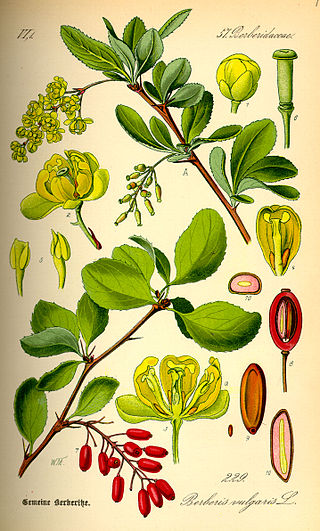Top Qs
Timeline
Chat
Perspective
Berberis vulgaris
Species of shrub From Wikipedia, the free encyclopedia
Remove ads
Berberis vulgaris, also known as common barberry,[3] European barberry or simply barberry, is a shrub in the genus Berberis native to the Old World. It produces edible but sharply acidic berries, which people in many countries eat as a tart and refreshing fruit.
Remove ads
Description
It is a deciduous shrub growing up to 4 metres (13 feet) high. The leaves are small, oval, 2–5 centimetres (3⁄4–2 inches) long and 1–2 cm (1⁄2–3⁄4 in) broad, with a serrated margin; they are borne in clusters of 2–5 together, subtended by a three-branched spine 3–8 millimetres (1⁄8–5⁄16 in) long.[4][5]
The flowers are yellow, 4–6 mm (1⁄8–1⁄4 in) across, produced on 3–6 cm (1+1⁄8–2+3⁄8 in) long panicles in late spring. The fruit is an oblong red berry 7–10 mm (1⁄4–3⁄8 in) long and 3–5 mm (1⁄8–3⁄16 in) broad, ripening in late summer or autumn. Its fruit persists for an average of 29.2 days, and bears an average of 1.3 seeds per fruit. Fruits average 76% water, and their dry weight includes 6.5% carbohydrates and 1.2% lipids.[4][5]
- Leaves
- Flowers
- Fruit
Remove ads
Subspecies
As of March 2024[update], Plants of the World Online accepted three subspecies:[6]
- Berberis vulgaris subsp. australis (Boiss.) Heywood
- Berberis vulgaris subsp. seroi O.Bolòs & Vigo
- Berberis vulgaris subsp. vulgaris
Distribution and habitat
The shrub is native to central and southern Europe, southern England,[7] northwest Africa and western Asia;[8] it is also naturalised in northern Europe and North America. In the United States and Canada, it has become established in the wild over an area from Nova Scotia to Nebraska, with additional populations in Colorado, Idaho, Washington state, Montana, and British Columbia.[9] It is also cultivated in many countries.
Ecology
The berries are an important food for many small birds, which disperse the seeds in their droppings.
B. vulgaris is the alternate host species of the wheat stem rust fungus (Puccinia graminis f. sp. tritici), a grass-infecting rust fungus that is a serious fungal disease of wheat and related grains. For this reason, cultivation of B. vulgaris is prohibited in Canada[10] and some areas of the US (Connecticut, Massachusetts, Michigan, and New Hampshire).[3]
Remove ads
Uses
Summarize
Perspective

The edible berries,[11] though rich in vitamin C, have a very sharp or sour flavour and are not widely consumed because the thorny shrubs make them difficult to harvest.
In Europe, the berries have been traditionally used as an ingredient in making jam. The berries are high in pectin which makes the jam congeal as it cools after having been boiled. In southwestern Asia, especially Iran, the berries are used for cooking, as well as for jam-making. In Iran, barberries are commonly used as a currant in rice pilaf.
زرشک zerešk is the Persian name for the dried fruit of Berberis spp., particularly also that of Berberis integerrima called زرشک بیدانه zerešk bi-dâne, literally 'seedless barberry',[12] which is widely cultivated in Iran. Iran is the largest producer of zerešk.
The South Khorasan province in Iran is the main area of zerešk and saffron production in the world, especially around Birjand and Qaen. About 85% of production is in Qaen and about 15% in Birjand. There is evidence of cultivation of seedless barberry in South Khorasan two hundred years ago.[13] A garden of zerešk is called زرشکستان zerešk-estân. Zerešk is widely used in cooking, imparting a tart flavour to chicken dishes. It is usually cooked with rice, called زرشک پلو zerešk polo, and provides a meal with chicken.
Other uses
The plant has been widely cultivated for hedges in New Zealand.[5]
A decoction of the plant has been used as a folk medicine to treat gastrointestinal ailments and coughs,[14] although its use has been limited due to the bitter taste of the bark and root.[15][16]
Remove ads
See also
- Berberis microphylla, calafate (a related shrub with similar berries, native in temperate South America)
References
Bibliography
External links
Wikiwand - on
Seamless Wikipedia browsing. On steroids.
Remove ads




